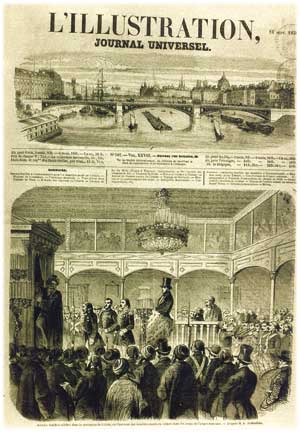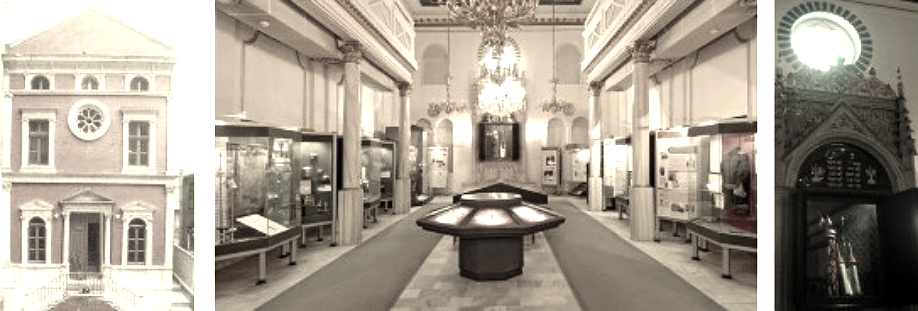Zulfaris Synagogue ( Jewish Museum of Istanbul Turkey) (officially Quincentennial Foundation Museum of Turkish Jews) is a cultural center established by the Quincentennial Foundation to inform the society of the traditions and history of Turkish Jewry. It was inaugurated on November 25, 2001. The Quincentennial Foundation was established in 1989 by 113 Turkish citizens, Jews and Muslims alike, to celebrate the five hundredth anniversary of Sephardim’s arrival to the Ottoman Empire.The idea of a museum was proposed by Naim Güleryüz who is now its curator and the foundation was financed by the prominent Jewish Kamhi Family.
The Museum
The museum building, formerly known as Zülfaris Synagogue, was restored and remodelled to suit a museum. There is evidence that this synagogue existed in 1671, and its foundations suggest that another structure was built during the colony of the Republic of Genoa. It was recorded as “Holy Sinavi (Synagogue) in Galata” or “Kal Kadoş Galata“, it was called as “Zulfaris” which is thought to have derived from the Persian word “Zülf-ü Arus“, meaning “the fringe of a bride”. However the actual building was re-erected over its original foundations presumably in the early 19th century, probably in 1823.
Time line

On September 1856 a ceremony was held at the Zülfaris Synagogue commemorating Jewish soldiers in the French army who fought and fell alongside the Ottomans against the Russians during the Crimean war. A military unit under the command of Staff Colonel Garbi Bey was present at this ceremony.1882 – The marble frame surrounding the Ehal (Ark) was donated by Samuel Malki.
- 1890 – Repair work was carried out with the financial assistance of the Camondo Family.
- 1904 – Restoration work was conducted by the Jewish Community of Galata presided over by Jak Bey de Leon.
- 1968 – Went through substantial repair.
- 1979 – Assigned for worship for the Jews of Thracian origin.
- 1983 – Last wedding in Zülfaris.
- 1985 – Ceased to serve as synagogue due to lack of a congregation, and allocated to the Quincentennial Foundation by the Neve Shalom Foundation.
- 2001 – With the financial backing of the Kamhi Family and the contributions of Jak Kamhi, it was inaugurated as a museum.
Museum Design
Jewish Museum of Turkey includes sections on the intermingling cultures of Jewish and Muslim Turks and ethnographic articles that depict the traditions of Turkish Jews, as well as the historical accounts of the Jewish odyssey from Spain to Turkey.
Entrance to the building is through an iron gate into a courtyard, in which a metal sculpture by Nadia Arditti is located. Titled the “Statue of the Rising Fire”, it is in memory of the Turkish Jews who died fighting in the Balkan, Dalmatia, Caucasus, Palestine, Tripolitania, Dardannelles, Korea and Liberation wars.
The octagonal main hall on the entrance floor information panels related to the history of the Zülfaris Synagogue, the Hahambaşı institution, daily life of Jews living in Istanbul and Anatolia, as well as artifacts such as letters, maps, tallits, fermans (imperial decrees) are on display. A copy of the Lausanne Treaty that recognized the sovereignty of the Republic of Turkey and with which Turkish Jews relinquished their minority privileges. The ehal (ark) on the same floor holds two torah scrolls which can be viewed. On another information panel, Jewish academicians who fled to Turkey from Europe during the Second World War and Turkish diplomats who helped Jews escape the Holocaust, some of which are Righteous Among the Nations are introduced.
The balcony, which used to be the prayer section for women holds some paintings depicting daily lives of the local Jewish community. The lower, ground floor is organized chronologically as an ethnographic section with photographs, paintings and objects pertaining to birth, circumcision, wedding, clothing, jewelry, etc.



Visiting Synagogues in Istanbul
You can visit the synagogues only by prior reservation via the offices of the Chief Rabbinate (+90 212 293 87 94).
You should make reservations during office hours (Mon-Thu: 9:30-17:00; Fri.: 9:30-13:00) and at the least 24 hours before your planned visit.
Make sure to have the passport numbers of the people planning to attend the visit and their full names at hand while making the reservation. Also, carry your passport with you for security checks during your visits to all synagogues.
Do you need rabbinate permission to visit the Zulfaris museum or is it open to the public??
Do we need to have a guide with us in order to visit the Ahrida Synagogue.. would that mean rabbinate permission plus the expense of a guide??
Any suggestions helpful. We have 1 long morning to visit Jewish Istanbul on Nov 3rd.
Thank you!!
You don’t need permission from the rabbinate to visit the Zulfaris museum. It is open to the public.
As for visiting active synagogues, you do need permission from the rabbinate. In case of the Ahrida Synagogue, you must make arrangements with a tour guide. You best bet is to contact the rabbinate and ask for a good tour guide they work with to visit it. It is my understanding that the tour guide will get you the permission of the rabbinate too. Don’t wait for the last moment though, since this may take a bit of time.
Kind regards,
We spent a great half-day touring some of the Jewish sites in Istanbul. We highly recommend it for anyone who wants to learn more about Istanbul’s rich Jewish history and culture.
The visit starts with the visit of the GALATA neighborhood, known to be one of the oldest Jewish neighborhoods, but very popular at the second half of the 18th century, with its famous tower built by the Genoese. The interior visit of the NEVE SALOM synagogue and the ASHKENAZI synagogue, followed by the visit of the TOFRE BEGADIM synagogue, used as an art gallery and the KAMONDO Stairs. Visit of the Zülfaris Synagogue, converted to the Jewish Museum of Istanbul.
In 1890, with the financial support of the Kamondo family, the building went through major restorations. In 1904, the interior of the temple was restored. The citation on the frame of the Ehal constructed in 1882 says:
“This Ehal was built by Samuel Malki with the wealth of his father Hayim Malki, September 1882”
In 1856, the Zulfaris synagogue was visited by Albert Calin, This visit was made in the memory of the Jewish soldiers who died in the Crimean War. The 24 January 1909, the election of the Chief Rabbi Haim Naum Efendi took place in this synagogue. In 1962, the synagogue went through another restoration process. Starting from November 1978, the Zulfaris synagogue was only opened on Saturdays for Sabbath prayers. On the September 1979, the synagogue was given to the Jewish congregation of Edirne. Later in the same year the temple was shut down.
In 1992, because of the celebration of the 500th anniversary of the Jewish migration from Spain during the Inquisition, to the Quincentenial Foundation and was restored to be the Jewish Museum. The museum was opened 25 November 2001.
At the entrance courtyard of the museum, there is a statue made by the Jewish sculptor Nadia Arditi, intitulated.
The history of the Jews in Turkey is much more extensive and colorful than the size of this small museum housed in the 19th-century Zulfaris Synagogue might suggest. Nevertheless, the museum provides a fascinating glimpse into the lives of Turkish Jews, whose presence in Anatolia is traced back to as early as the 4th century BC. In 1492, the Spanish Inquisition drove Sephardic Jews from Spain and Portugal, and Sultan Beyazıt II welcomed the refugees to the Ottoman Empire. A large Jewish population thrived here for centuries, and some older Turkish Jews still speak a dialect of medieval Spanish called Ladino, or Judeo-Spanish. Today, Turkey’s Jewish community numbers about 23,000, most of whom live in Istanbul, which has 18 active synagogues (three of which are on the Princes’ Islands). The museum exhibits, most of them based on items donated by local Jewish families, include photographs, documents, and an ethnographic section with changing exhibits on subjects such as marriage traditions. There are also religious items brought from some very old (no longer active) synagogues in other parts of Turkey.
Ahrida synagogue and Zulfaris synagogue are two of the most significant synagogues in Istanbul. May be it will be interesting for you to learn that Ahrida synagogue derives its name from Ohrid. This is the largest and most splendid synagogue in Balat, with a capacity of 350 people. The present building of Zulfaris synagogue was probably reconstructed in 19th century on the foundations of the original one. It was restored in 2001 and now it serves as the “Jewish Museum of Turkey.”
Story of the Turkish Jews who were deported from Spain in 1492 and are now living in Turkey for more than 500 years in peace and harmony.
The museum building, formerly known as Zülfaris Synagogue, was restored and remodelled to suit a museum. There is evidence that this synagogue existed in 1671, and its foundations suggest that another structure was built during the colony of the Republic of Genoa.It was recorded as “Holy Sinavi (Synagogue) in Galata” or “Kal Kadoş Galata”, it was called as “Zulfaris” which is thought to have derived from the Persian word “Zülf-ü Arus”, meaning “the fringe of a bride”. However the actual building was re-erected over its original foundations presumably in the early 19th century, probably in 1823.